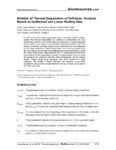Kinetics of Thermal Degradation of Cellulose: Analysis Based on Isothermal and Linear Heating Data

Use this link to cite
http://hdl.handle.net/2183/34950Collections
- Investigación (EPEF) [590]
Metadata
Show full item recordTitle
Kinetics of Thermal Degradation of Cellulose: Analysis Based on Isothermal and Linear Heating DataAuthor(s)
Date
2016-05-16Citation
López-Beceiro, J., Álvarez-García, A., Sebio-Puñal, T., Zaragoza-Fernández, S., Álvarez-García, B., Díaz-Díaz, A., Janeiro, J., and Artiaga, R. (2016). "Kinetics of thermal degradation of cellulose: Analysis based on isothermal and linear heating data," BioRes. 11(3), 5870-5888
Abstract
[Abstarct]: In spite of the many studies performed, there is not yet a kinetic model to predict the thermal degradation of cellulose in isothermal and non-isothermal conditions for the full extent of conversion. A model proposed by the authors was tested on non-oxidising thermogravimetric data. The method consisted of initially fitting several isothermal and non-isothermal curves, then obtaining a critical temperature and an energy barrier from the set of fittings that resulted from different experimental conditions. While the critical temperature, approximately 226 °C, represented the minimum temperature for the degradation process, the degradation rate at a given temperature was related to both the critical temperature and the energy barrier. These results were compared with those observed in other materials. The quality of fittings obtained was superior to any other reported to date, and the results obtained from each single curve were in line with each other.
Keywords
Cellulose
Pyrolysis
Kinetic
Thermogravimetry
Pyrolysis
Kinetic
Thermogravimetry
Editor version
ISSN
1930-2126





